Christmas trees, sweaters, gifts in shipping mess: How supply chain issues will affect holiday shopping
Go back just a year ago and it wouldn't have mattered that three 40-foot corrugated metal shipping containers stuffed with thousands of ugly holiday sweaters couldn't make their way out of a California port.
Who was going out to the bars? Or heading to a big family dinner? Who worried about buying a new quirky sweater when life looked grim as COVID-19 cases soared?
Fred Hajjar, president of Commerce Township, Michigan-based UglyChristmasSweater.com, sold a lot of holiday lounge pants and pajamas last year as people stayed home.
Now he sees the ugly sweaters making a beautiful comeback as more people feel festive, plan to see family and continue to shop from home. He estimates the online retailer will sell 100,000 or more holiday sweaters.
"I'm fairly confident, it's going to be a big year," Hajjar said. "Christmas sweaters, there'll definitely be a shortage."
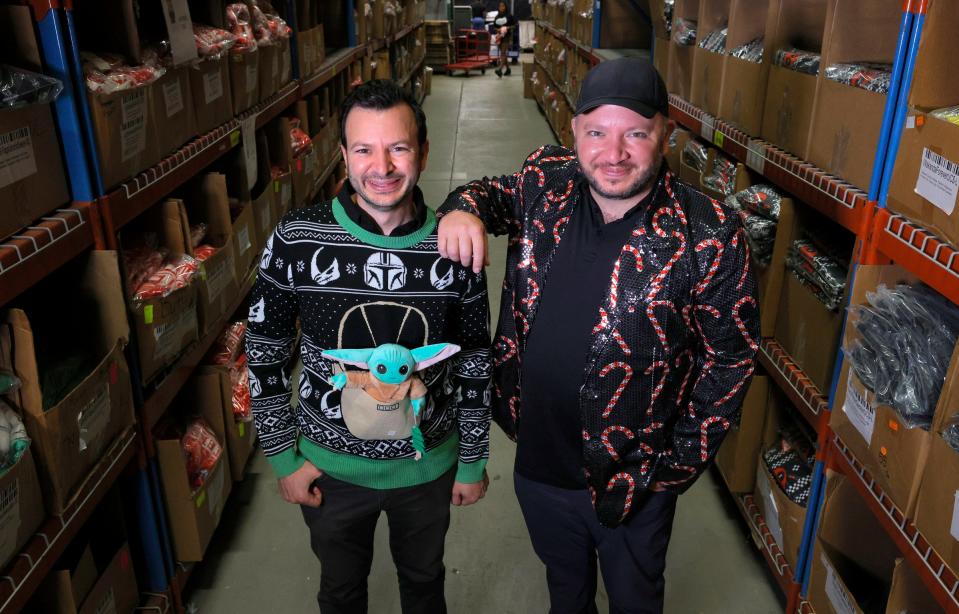
Demand is driving optimism this year but kinks in the supply chain, including bottlenecks along various points in the transportation system, could cut into supply. We're hearing talk about potential shortages of toys, trees and, yes, maybe even holiday sweaters.
Where's Jay and Silent Bob?
The ugly sweater story is a local snapshot of shortages, higher prices and headaches or opportunities, depending on your point of view. Many ugly vintage Christmas sweaters, after all, started out in the late 1980s and as another person's merry fashion statement.
Hajjar is facing skyrocketing transportation costs, extraordinary delays and worrying about those three containers of sweaters and pajamas.
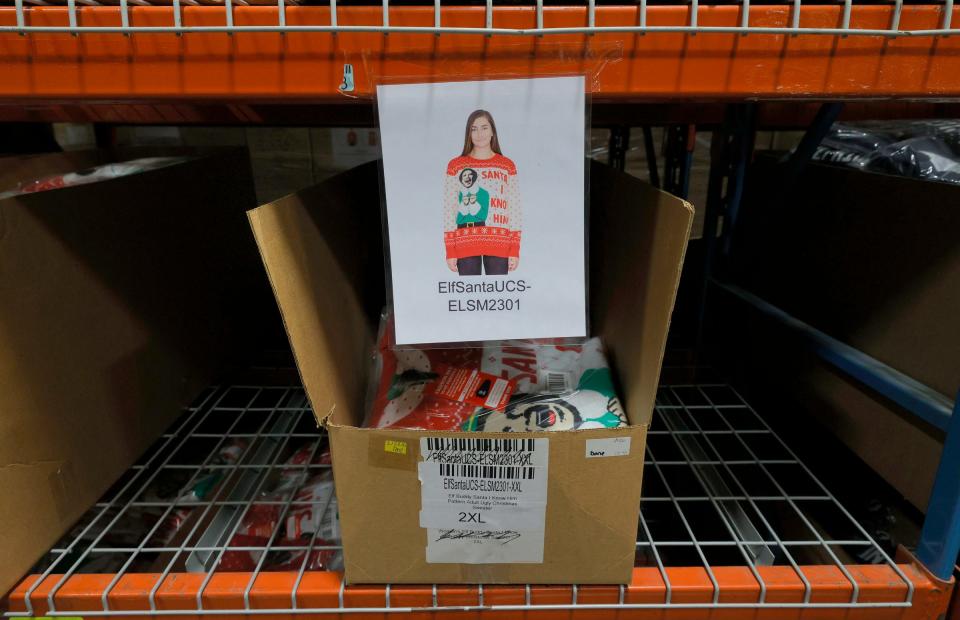
"Ours are stuck, I believe, in Long Beach," Hajjar said.
The containers are packed with a popular holiday sweater featuring the movie characters Jay and Silent Bob and a special line of holiday pajamas where families can have their names printed on the PJs. A family of three can spend $120 or more on matching holiday-themed sleepwear.
Roughly, 30,000 pieces of fun holiday gear – each container can hold 10,000 items – should be in Commerce Township, ready go, but in mid-October, they were caught up in one giant supply chain mess.
What it takes to get back to normal
This holiday, many people want to get back to normal – or at least within six feet of normal.
And for many, no holiday is complete without showing up somewhere in a garish green-and-red sweater with Dwight K. Schrute from "The Office" on the front or donning a sparkly, candy cane-covered black blazer.
Many are giving up on sitting on the couch trying to Zoom for the holidays. People have money to spend, thanks to the federal stimulus rollouts and the uptick in the economy.
"If you follow college football at all, there's like 100,000 people in the stadiums," said Hajjar, who got his start in the novelty clothing business selling T-shirts out of his Hubbard Hall dorm room at Michigan State University. Make no mistake, his 42,000-square-foot warehouse is stacked with boxes and boxes and boxes of clever sweaters ready for the season.
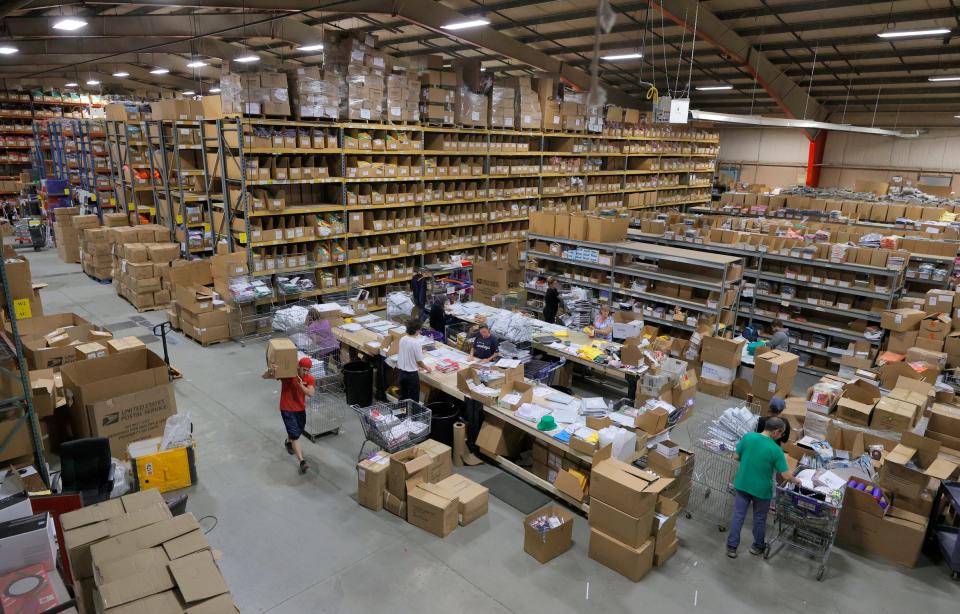
What's going to be tougher to buy this holiday – or much higher priced – may be debatable. Retailers, of course, have an incentive to get customers to buy early – and often – as the fear of missing out builds into a frenzy.
Clogs clearly exist in the supply chain system as a backlog of cargo ships creates a traffic jam in the Pacific Ocean. And logistics experts warn that the trucking system is short on drivers.
Baby Yoda, Kiss and 91 other designs
Yet as I walked with Hajjar, 41, and his brother Mark Hajjar, 38, through the Oakland County, Michigan, warehouse, I had to wonder: What holiday shortage? They have 93 varieties of holiday sweaters this year.
They pulled a black, gray, white and red "Merry KISSmas" sweater out of the packaging and showed me how the Gene Simmons-licensed red tongue flaps up and down with a special gadget in the sleeve. Price: $52.95 to $59.99 for bigger sizes.
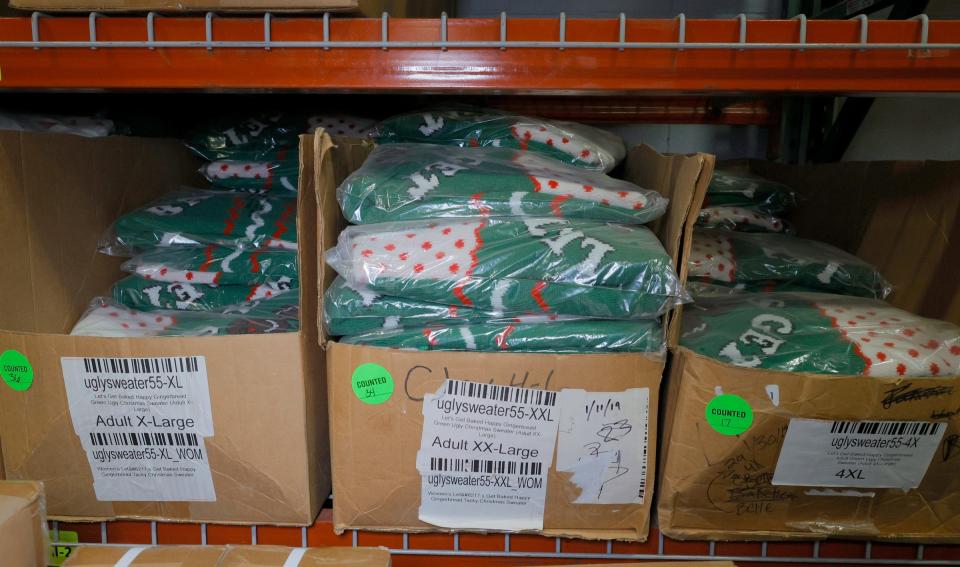
And they highlighted the new black-and-white-and-green, 3D Baby Yoda sweater – which Whoopi Goldberg was photographed wearing on "The View" late last December. Baby Yoda's left hand, which is holding some Christmas trees, moves when you squeeze him. Price: $49.95.
The Baby Yoda sweater was sent to influencers last year, including a major Star Wars blog, even though it wasn't really available to be sold in time for Christmas 2020. The Star Wars blog, Hajjar said, then sent the sweater to Goldberg, a big Baby Yoda fan, and she actually wore it on the show.
"We didn't even expect it," Hajjar said.
Goldberg loves holiday sweaters and launched a line of her own Christmas sweaters back in 2016 that retailed then for $139.

Last year, though, Goldberg declared on "The Tonight Show Starring Jimmy Fallon" that she wasn't going to feature a holiday sweater on the show. "'Cause who was going out? Nobody. Nobody's going out. They're not partying in sweaters." Instead, Fallon showed off Goldberg's red snow globe holiday scarf.
Where are the cars?: Elio Motors promised a next-gen, 84 mpg car and got millions in deposits
Fast food and vaccines: In-N-Out decision to not check customers' vaccination status stirs political debate
Family party back on holiday calendar
This year, many remain concerned about the path of the COVID-19 delta variant. Even so, half of consumers plan to attend a gathering with family – up significantly from 26% last year, according to a September survey by KPMG.
While some of his inventory could arrive late to his warehouse, Hajjar's speculating that supply chain disruptions could work in the company's favor too.

Many big retailers, he reasons, will prioritize shipments and might not purchase as many seasonal items that won't sell if they get caught in delays and show up in February.
The company, founded in 2011, has had to work hard to outsmart big retailers that began stocking some garish holiday sweaters several years ago. The Michigan company has come up with creative designs – such as a "Baby It's COVID Outside" sweater – to play off pop culture and offer a twist that might not be found in Kohl's or Walmart.
In addition, the company has worked directly with big brands – such as Red Lobster, Swiss Miss and cloud software giant Salesforce – to design and make holiday sweaters for promotions, employees and retail sales. The Red Lobster sweater promoted in 2019, for example, sold for $39.99 and was adorned with lobsters and shrimp, It also had an insulated pouch where you could keep the Cheddar Bay biscuits warm.
Christmas-themed apparel isn't all that's at risk because of supply chain issues this holiday.
The Hajjar brothers, who grew up in West Bloomfield, Michigan, sell lawn decorations – some in the PG-13 category like the reindeer playing adult games – online too.
One shipping container full of inflatable holiday lawn decorations is sitting in the Port of Vancouver, British Columbia, unable to get unloaded as a result of supply chain woes that were made worse because of the pandemic. Prices on those lawn decorations increased an average of 26% this year. Price increases range from 18% to 42% on some items.
Hajjar's company's cost of shipping has gone up from $3,900 a container in 2019, he said, to $28,000 a container in September. That's nearly more than double the $15,000 cost in April. Smaller operations are facing greater pressure from higher shipping costs.
Hajjar estimates that the price of sweaters will go up around 10%, as the company will pass on part of its extra cost to customers.

We're seeing potential trouble spots when it comes to imports of goods relating to Christmas festivities, based on government data, according to Jason Miller, associate professor of logistics in the department of Supply Chain Management at Michigan State University's Eli Broad College of Business.
He noted that there's been a dropoff in the metric tons of imports of Christmas items through August, compared with the same time last year.
Will there be a Christmas tree shortage?
The American Christmas Tree Association, for example, predicted that both live and artificial trees will be hit by holiday shortages and price hikes too. Prices of artificial trees, for example, could go up 20% to 30% this season.
The group blamed the price increases on "extreme weather events in the Pacific Northwest and Midwest, supply chain congestion in and out of ports, and shipping container shortages."
Wayne Bronner, CEO of Bronner's CHRISTmas Wonderland in Frankenmuth, Michigan, said his store is well-stocked with high-quality Christmas trees, priced at $300 and up, and Bronner's has not raised prices on the trees. But he is experiencing some issues relating to the supply chain disruptions.

"We're receiving things about two months later than we anticipated," said Bronner, whose father, Wally Bronner, founded the store in 1945. Bronner says his father has been in heaven since 2008.
The year-round Christmas store, which currently has 510 staff members, saw shipments that would have arrived in July and August later show up in September and October. Sometimes, the delays involve Christmas ornaments.
But he's not worried.
"We have over 8,000 styles, so it really hasn't cramped our style too much," Bronner, 69, said.
One container in transit somewhere contains some Christmas trees and decorative silhouettes that easily light up a window with a Nativity scene or Santa design held by suction cups.
Even so, he's not overly concerned about holdups at this point. Bronner's went into this year with a higher than usual inventory, he said, after in-store sales suffered during capacity limits imposed during the pandemic in 2020 but online sales took off at www.bronners.com.
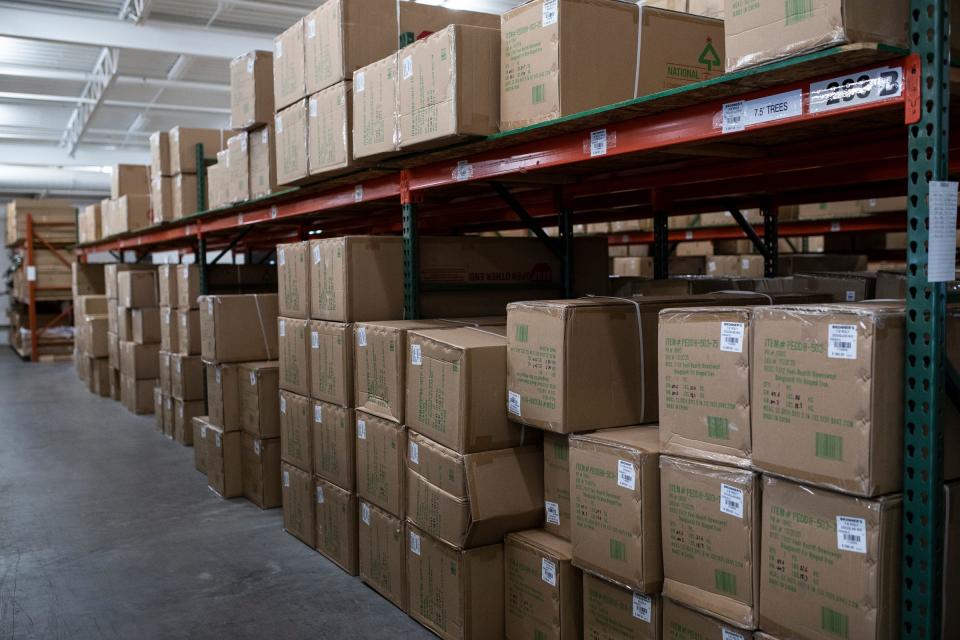
"Last year was very uncertain," he said. "We didn't know what to expect."
This year, he said, people seem ready to get out after being cooped up for a long time. But again, he said, some uncertainty remains given the delta variant.
While much of the conversation about holiday shortages is focused on potential lack of supply, some experts say the trouble started because of an incredible spike in demand after trillions of dollars in stimulus cash flooded into households.
The third economic stimulus payment that rolled out in March was the largest of the bunch. Eligible married couples, for example, received up to $2,800 – plus $1,400 for each dependent.
"All of this stimulus money was provided and people couldn't spend it on services, so they spent it on goods," MSU's Miller said.
"The March 2021 stimulus is the key factor that pushes consumer demand to even higher levels," Miller said.
Incredible gains in the stock market and cryptocurrency, he said, only gave some people even more buying power.
Record demand in the spring caused retailers to restock quickly and contributed to chokepoints in the supply chain.
What many don't understand, Miller said, is that the hike in shipping costs isn't uniform and smaller importers face a disproportionate impact. As a result, he said, prices won't necessarily skyrocket everywhere due to rising shipping costs.
Powerhouse importers – such as Walmart, Target, Home Depot, Lowe's and Costco – pay nowhere near the dramatic prices, he said, now faced by smaller importers, like UglyChristmasSweater.com.
"Do we have a log jam? Yes, we do," Miller said.
Miller said some smaller businesses may have decided that it's simply not doable to take on the higher costs they're facing for shipping some seasonal goods that don't have high profit margins.
Retail sales, adjusted for inflation and excluding motor vehicle and parts dealers rose an incredible 17.1% from January through August, he said.
And, Miller said, imports increased 16.9% for this same time frame.
He noted that the shipping and transportation systems in place could not possibly have that much excess capacity to easily absorb this surging demand.
Other supply chain challenges
Unloading a ship is only part of it, of course. Chokepoints can pop up throughout the system.

Trucks must haul goods across the country once they're unloaded at the docks.
Items also have to be warehoused and then more regional or local deliveries must be made to stores. Clerks must be there to stock the shelves.
Challenges include bottlenecks on highways, clogged rail yards, and ports, as well as shortages of containers and overburdened warehouses, especially near the largest ports in the U.S.
"While I've read a lot about labor shortages," Miller said, "the finalized data from the Quarterly Census of Employment and Wages shows there has been substantial headcount increases in warehousing, with California seeing an increase of over 40,000 workers."
Yet, he said, there are fewer long-distance truck drivers than before COVID-19, which makes it difficult to handle additional import volume.
On Oct. 13, President Joe Biden announced efforts to address supply chain bottlenecks. The Port of Los Angeles agreed to essentially double its hours and go to 24-hour, seven-day-a-week operations. The Port of Long Beach launched nighttime and weekend shifts a few weeks ago.

Biden noted in his remarks that 40% of shipping containers that are imported into the U.S. come to the two ports in California.
The International Longshore and Warehouse Union members agreed to work extra shifts.
FedEx and UPS also committed to significantly increasing the number of goods they are moving at night.
While some are hopeful that such efforts can help, many do not see the situation resolving soon.
Brian Calley, president of the Small Business Association of Michigan, said the supply chain concerns started out as a few problems here and there but the concerns are more widespread throughout a variety of businesses.
"Little things that you never really had to think about are being impacted or disrupted," Calley said.
"Things have to work very much in harmony for these worldwide supply chains to work effectively."
Small business struggles to figure out what's next
Much of the focus now is on the holiday crunch time for retailers and those selling seasonal goods online.
But the clogs in the supply chain present serious threats to the financial well-being of so many small businesses and others across the country – not simply those in retailing.
"It's madness," said Erick Stewart, president of STEWART Industries in Battle Creek, Michigan, a diverse business that employs about 50 people and specializes in assembly, inspection and new product innovations for the automotive, aerospace and medical industries.
Given the troubles at California ports, Stewart said he opted to try to have five or six 40-foot containers of parts and supplies shipped through the Port of Savannah in Georgia.

But that port is now seeing a major backup where nearly 80,000 containers stacked up at the facility after the cargo was unloaded from the ships. The issue there is getting those goods carted away. But it's a logistics nightmare due to the trucking shortage and other issues.
"You can plan for two months from now but you don't know what's going to happen," Stewart said.
The shipment to Georgia is due in mid-to-late November and contains medical supplies, such as 3-ply face masks and other personal protective equipment for medical facilities, such as clinics, hospitals and school systems.
He's concerned that any delays could force already supply starved hospitals or school systems to pay higher prices or be driven to buy substandard products as an alternative.
Stewart, 50, has been in business for 21 years and has seen many challenges – the 9/11 terrorism crisis, the 2008-09 recession, the 2011 earthquake and tsunami in Japan that hurt the global automotive business, civil unrest.
"But this is definitely," he said, "the longest sustained challenge."
And he suggested that there's no one silver bullet answer given the multitude of layers associated with the problem – the ships that can't be unloaded, the overburdened ports, the shortage of drivers, the increased demand from consumers and, yes, the efforts by some businesses to order more than they'd normally need to stockpile goods to avoid shipping troubles down the road.
The uptick in the delta variant pushed up hospitalizations and drove up the need for medical equipment and supplies that are imported from overseas, too.
"Some of it is economic. Some of it is human behavior. Some of it is desperate need for products to save lives," Stewart said.

While supply chain issues arose three months or so into the pandemic in 2020, Stewart said, the situation is now the worst it has been.
"It's a logistics nightmare," he said.
He compared the situation that small businesses have with importing, he said, to the hiring challenges restaurants face now.
The restaurants are paying more for workers; the smaller business owners are paying more for shipping.
"You look at it from a small business perspective," he said. "How are you going to absorb that?"
"Holy cow, if you can't get products and services how do you stay in business?"
Gridlock isn't going to go away soon, experts warn, and could even remain a threat for far more than ugly Christmas sweaters well into 2022.
Folllow Detroitt Free Press personal finance columnist Susan Tompor on Twitter @tompor.
This article originally appeared on USA TODAY: Supply chain disrupts 2021 holiday shopping as shortages continue

 Yahoo Movies
Yahoo Movies 